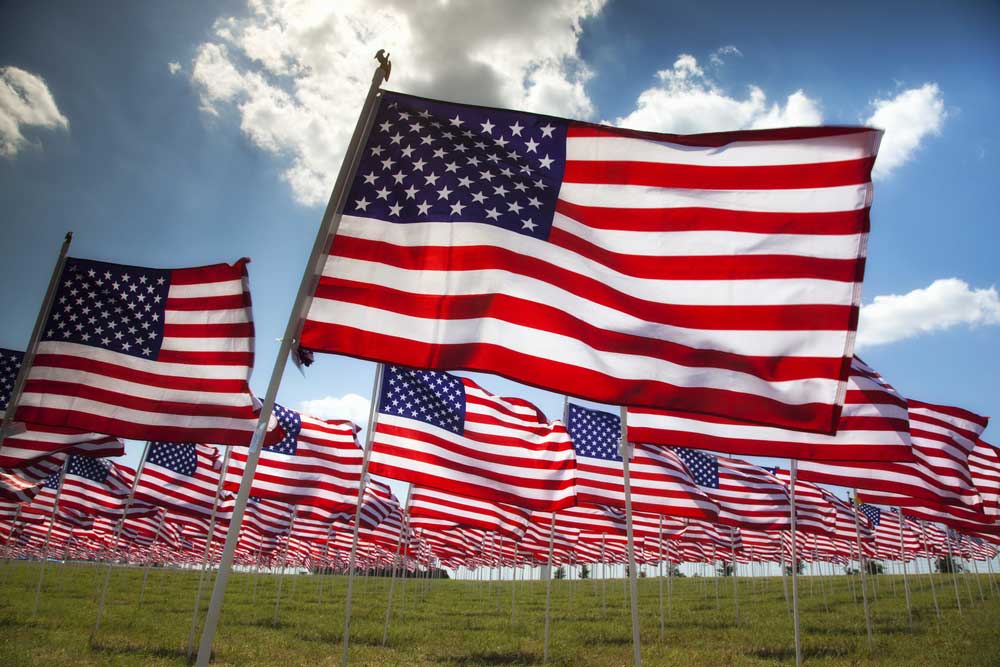June 2023
Feature Article
A brief history of Flag Day in the United States
By Corbin Crable
You might have pledged allegiance to the American flag every morning in elementary school, but do you know the story behind the holiday that bears its name?
Flag Day falls on June 14 of every year, just three weeks shy of Independence Day. In 1777, the Continental Congress of the United States adopted a resolution stating that the flag of the United States “should be of 13 stripes of alternate red and white, with a union of 13 stars of white in a blue field, representing the new constellation.” The 13 stars and stripes, of course, represented the 13 original colonies.
According to the U.S. Veterans Administration, the flag “was first carried into battle on Sept. 11, 1777, in the battle of the Brandywine,” but the claim of organizing the first official observance of Flag Day has been made by many institutions and on many dates. The first, the VA states, was during a celebration in Hartford, Conn., in 1861.
“In the late 1800s, schools all over the United States held Flag Day programs to contribute to the Americanization of immigrant children, and the observance caught on with individual committees,” the VA website states.
Generally, the first official Flag Day is recognized as having originated in New York in 1889, when a teacher of a free kindergarten sponsored ceremonies to observe the congressional resolution’s anniversary. Only a few years later, in 1897, New York’s governor “ordered the displaying of flags over all public buildings in the state,” the website reads. Other claims to the first Flag Day observance come from Pennsylvania and Wisconsin.
“Presidents Woodrow Wilson and Calvin Coolidge issued proclamations asking for June 14 to be observed as National Flag Day,” according to the VA website, “but it wasn’t until Aug. 3, 1949, that Congress approved the national observance and President Harry Truman signed it into law.”


Stars and Stripes forever
The History Channel’s website clarifies these and other facts about Flag Day, and even dispels myths surrounding the flag itself. Among them, “It is widely believed that Betsy Ross, who assisted the Revolutionary War effort by repairing uniforms and sewing tents, made the first American flag. However, there is no historical evidence that she contributed to Old Glory’s creation. It was not until her grandson William Canby held an 1870 press conference to recount the story that the American public learned of her possible role. It has since been confirmed that Francis Hopkinson, a delegate from New Jersey who signed the Declaration of Independence, designed the American flag.”
In addition, according to The History Channel, less than a decade after the observance of Flag Day was signed into law, a 17-year-old high school student in Ohio, Bob Heft, when it became clear that Alaska and Hawaii would be granted statehood, stitched 50 stars onto his family’s American flag that had 48 stars displayed across its blue field. He altered the flag for a class project – for which he received a grade of B-.
“Heft also sent the flag to his congressman, Walter Moeller, who presented it to President Eisenhower after both new states joined the Union. Eisenhower selected Heft’s design,” The History Channel’s website reads, “and on July 4, 1960, the president and the high school student stood together as the 50-star flag was raised for the first time. Heft’s teacher promptly changed his grade from a B- to an A.”
Today, the federal government has designated June 11-17 as National Flag Week, during which time the American flag should be displayed on all government buildings.
For more information on Flag Day, its history, and customs and etiquette surrounding the American flag, visit www.va.gov and www.history.com.

